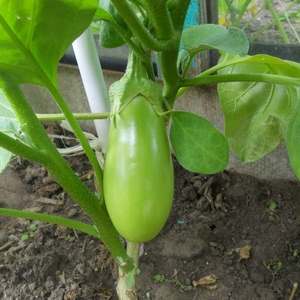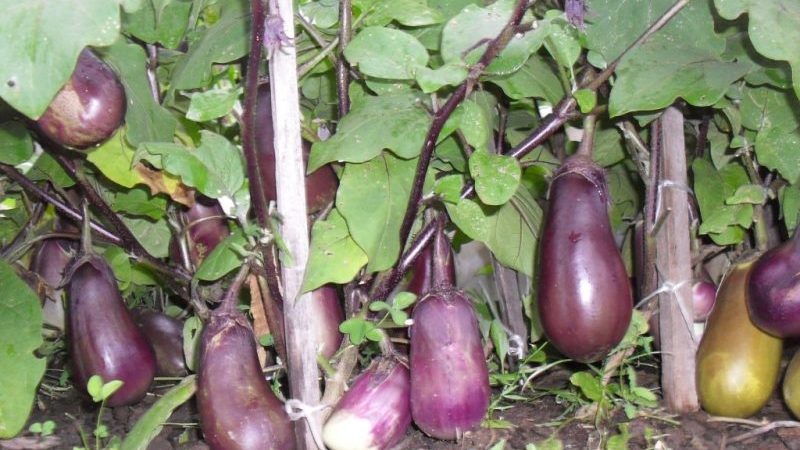Why eggplants do not turn blue, but turn green and how this can be prevented
The usual color for ripe eggplants is from dark blue to purple. Therefore, when the fruits, instead of turning blue, turn green, gardeners have natural questions: why is this happening and can vegetables be green to eat? You will find detailed answers in the article, as well as learn about the varietal characteristics of eggplants. It turns out that in nature there are "blue" and other colors.
The content of the article
Why eggplants don't turn blue, but turn green

Eggplant accumulates solanine, a toxic alkaloid. It not only gives the vegetables a bitter taste, but also their green color. Young fruits contain an acceptable amount of solanine, and it does not make itself felt. But in overripe specimens, the level of this toxic substance is off scale. In this case, not only the color of the eggplant peel changes from blue to green (sometimes to yellow or even brown), but also the color of the pulp and seeds. They darken and become brown.
Common Causes
In most cases, the reason for the greening of eggplants lies precisely in the late harvest. But it also happens that the "blue" acquire a greenish tint due to an excess of nitrogen or a lack of light. This leads to the fact that their development is inhibited, and the fruits begin to brighten.
Varietal features
So, we found out that eggplants turn green when overripe or, conversely, with developmental problems. But these are not all reasons. there is varieties, the peel of which, when ripe, remains green or turns white-green. These cultures came to us from Asia and North America and are gaining more and more popularity in our country.
These varieties include:
- Emerald F1;
- Alenka;
- Greenish;
- Green F1;
- Yoga;
- Louisiana;
- Thai green;
- Green Galaxy F1.
These varieties have light-colored peel: from white to light green, salad. There is a color with pigmentation or stripes. Their shape is diverse and even unusual for eggplants: spherical, curved cylindrical, elongated cylindrical slightly flattened, oval. The color of the flesh ranges from creamy white to light green.
In all these varieties, solanine is either completely absent, or its content is minimal (0.0025% per 100 g of dry matter). And the taste of these varieties differs in that it completely lacks the bitterness characteristic of dark blue eggplants. Among them there are sweetish fruits that can be eaten raw. They are added to salads without prior heat treatment and soaking. These include, for example, the eggplant Alenka. And the taste of the Emerald variety fruit resembles a mushroom one.
What to do and is it possible to eat such eggplants
With varieties with a greenish peel, everything is clear. They can be safely eaten, even without first soaking in salt water. But is it possible to eat eggplants with a green peel, unusual for varieties?
Potential consequences of eating green fruits
In such eggplants, the amount of solanine is off scale. They are easy to poison. Symptoms of solanine poisoning include:
- dizziness;
- disorientation;
- migraine;
- nausea;
- vomiting;
- stomach pain;
- diarrhea;
- high temperature.
If these symptoms appear, wash your stomach and take sorbents (Enterosgel or white coal).
With the systematic use of small doses of solanine, a rash and sores in the mouth appear. It also leads to insomnia.
Attention! If symptoms include tachycardia, convulsions, or loss of consciousness, call an ambulance immediately.
Treatment

There are overripe green fruits, although not desirable, but possible. However, they must be processed before use.
To remove the harmful alkaloid solanine and bitterness from a vegetable, do the following:
- Cut the eggplants (cubes, circles).
- Sprinkle them with salt and leave for 40-60 minutes. Wait for them to release the juice and drain it.
- Rinse the vegetable pieces well with running water. Remove large seeds. Put the eggplants in a colander and squeeze.
- Blanch the eggplant slices in boiling salted water for 5-7 minutes.
- Peel off the green skin (this is easy to do after blanching).
The processed vegetables are ready for further cooking.
Seed material
Despite the fact that after the performed manipulations, overripe eggplants can be eaten, we do not recommend doing this. Overripe fruits are recommended to be left for seeds. For this:
- Pick out the largest fruits with the correct shape.
- Wait until the peel begins to dry and only then rip them off.
- Place the harvested fruits in a dark place for a couple of weeks to ripen the seeds.
- Collect seed.
Preventive measures against eggplant greening

To prevent greening of eggplants from overripe, pick them at the time of technical maturity (comes a little earlier than biological). It is better to pick young, slightly unripe fruits than to be late. These vegetables will have a thin skin and a small, loose seed portion.
Attention! To determine technical ripeness, press on the eggplant without removing it from the bush. A small dent will form, which will disappear after a couple of seconds. If there is no trace left when pressed, then you can harvest. And, if the dent is deep and does not disappear, then in front of you is an overripe eggplant, and it is better to leave it for seeds.
Solanin accumulates not only in overripe fruits. Ripe eggplants can turn green if watering is insufficient in dry weather. To prevent this, watch out for timely watering. And even at the planting stage, choose well-lit places for eggplants.
Read also:
Hybrid eggplant "Clorinda" from Dutch breeders.
Review of the "Black Prince" eggplant variety and instructions for growing it.
Heat-loving hybrid of eggplant "Valentine f1" from Dutch breeders.
Conclusion
If this is not a feature of the variety, then the green shade of ripe eggplants indicates their overripe or improper development. In such fruits, the content of a toxic substance - solanine - is increased. Eating overripe eggplants without special treatment is hazardous to health. Therefore, try to harvest immediately after the onset of technical maturity.